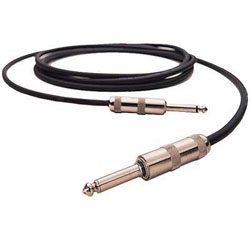
What type of shield works best against 60-cycle hum from power transformers and AC cables?
The sad truth is that the most offensive “hum-producing” frequencies (60 and 120 Hz) generally emitted by transformers and heavy power cables are too low in frequency to be stopped by anything but a solid tube of ferrous (magnetic) metal—iron, steel, nickel, etc.—none of which contribute to the flexibility of a cable!
For magnetically-coupled interference, the only solution is to present as small a loop area as possible. This is one of the reasons that the twisted-pair configuration generally used in balanced-line applications became popular.
Fortunately the high input impedances generally found in unbalanced circuits minimize the effects of such interference.
Don’t run instrument cables parallel to extension cords. Don’t coil up the excess length of a “toolong” cable and stuff it through the carrying handle of a amp—this makes a great inductive pickup loop for 60 Hz hum!
What does the outer jacket do? What is it made of?
The jacket is both armor and advertisement; it protects the cable from damage and enhances the marketability of the assembly. As armor, the jacket must resist abrasion, impact, moisture and sometimes hostile chemicals (Bud Light, for instance).
As advertisement, it may be distinctively colored or printed with the name of the manufacturer or dealer for product identification.
The materials used for jacketing are the same type as those used for the inner insulation (thermoset or thermoplastic), but the choice is dictated less by electrical criteria and more by physical durability and cosmetic acceptability.
What is the best cable jacketing material?
For years rubber or neoprene were preferred for their superior abrasion resistance and flexibility, but modern thermoplastic technology has produced a number of PVC compounds that are soft and flexible but also very tough.
As previously noted, thermoplastic processing is cheaper, faster and more predictable than that for thermoset materials.
Only very specialized situations requiring oil or ozone resistance or extremes of temperature and climate demand neoprene or Hypalon jacketing.
The use of PVC has two other major advantages. PVC is not as elastic as rubber or neoprene, and this lack of “stretch” lends additional tensile strength to the resulting assembly by taking some of the strain that would otherwise be borne solely by the center conductor.
This has made a dramatic improvement in the reliability of currently manufactured instrument cables.
The other important property of PVC is its almost limitless colorability. Once found only in gray or “chrome vinyl,” PVC-jacketed cable now ranges from basic black through brilliant primary colors to outrageous “neon” shades of pink and green.
Bibliography
• Ballou, Greg, ed., Handbook for Sound Engineers: The New Audio Cyclopedia, Howard W. Sams and Co., Indianapolis, 1987.
• Cable Shield Performance and Selection Guide, Belden Electronic Wire and Cable, 1983.
• Colloms, Martin, “Crystals: Linear and Large,” Hi-Fi News and Record Review, November 1984.
• Cooke, Nelson M. and Herbert F. R. Adams, Basic Mathematics for Electronics, McGraw-Hill, Inc., New York, 1970.
• Davis, Gary and Ralph Jones, Sound Reinforcement Handbook, Hal Leonard Publishing Corp., Milwaukee, 1970.
• Electronic Wire and Cable Catalog E-100, American Insulated Wire Corp., 1984.
• Fause, Ken, “Shielding, Grounding and Safety,” Recording Engineer/Producer, circa 1980.
• Ford, Hugh, “Audio Cables,” Studio Sound, Novemer 1980.
• Guide to Wire and Cable Construction, American Insulated Wire Corp., 1981.
• Grundy, Albert, “Grounding and Shielding Revisited,” dB, October 1980.
• Jung, Walt and Dick Marsh, “Pooge-2: A Mod Symphony for Your Hafler DH200 or Other Power Amplifiers,” The Audio Amateur, 4/1981.
• Maynard, Harry, “Speaker Cables,” Radio-Electronics, December 1978,
This article contributed by Pro Co Sound.
